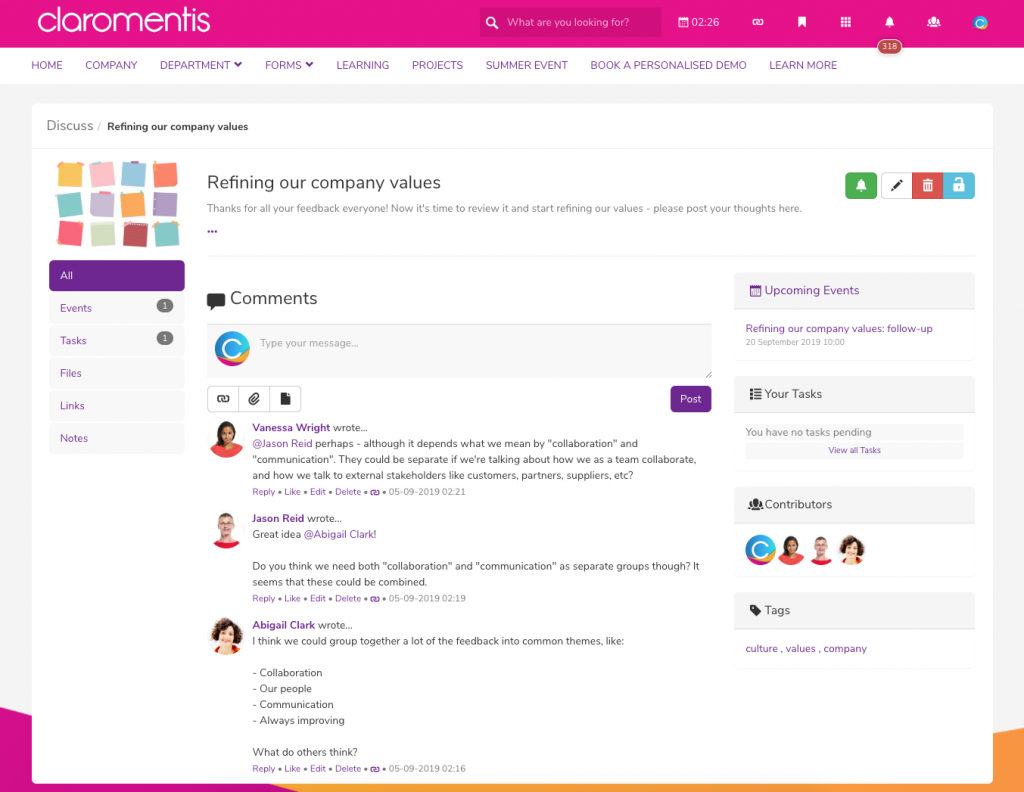Business values and company culture go together like mashed potatoes and gravy. Is there really any point in having one without the other? The short answer is: no.
Simply put, company culture cannot exist if you don’t have a set of core business values in place. Why? Because business values shape every behaviour, decision, and action that happens in your company. Core values influence your brand, determine how others see you from the outside, and give your company purpose. If these values are not clearly defined, then there is no global workplace culture to guide employees in their day-to-day role – everyone will be doing their own thing.
A lack of purpose also affects a company’s bottom line. A survey by LinkedIn and Imperative found that 85% of purpose led companies saw positive growth. 42% of non-purpose led companies showed a drop in revenue.
If you’ve yet to define your company’s values – don’t panic! There are a few simple steps you can take to create, articulate, and share your core values, which will ultimately shape your corporate culture. In this blog, we’ll share how we created our own values-driven culture at Claromentis. We’ve won Real Business’s Top 25 SME Culture Leaders award for two years running, so we must be doing something right 😉
![[FREE GUIDE] HOW TO CREATE AN ONLINE COMPANY CULTURE](https://no-cache.hubspot.com/cta/default/5025095/404e6163-5acd-40fd-9d11-858bdb05ea69.png)
Ask your staff
Who better to define your core values than the very people who live them every day? Your staff will have a wealth of knowledge and experience from working with customers, developing products, or delivering services on a daily basis, so ask them to share their thoughts. Chances are, they are working on a set of unspoken principles already, but it’s important to get these out in the open.
A simple way to capture feedback is via digital workplace tools, like surveys, polls, and feedback e-forms. At Claromentis, we used Mentimeter to get real-time feedback from our staff during a company-wide stand up. We asked each team member to submit three words on the app that described how they felt about Claromentis, and we watched in anticipation as everyone’s feedback appeared live on-screen.

The results are in… the words our staff used to describe how they felt about Claromentis ❤️
From the results, we could see patterns and trends emerging, which we used as a starting point for building our company values. We then shared them on our intranet social media channels, to spread awareness and invite further discussion.
Analyse and refine your values
Once you have collected feedback from your employees, it’s time to analyse the results and start building out your values into something tangible and meaningful. Are there any common themes that could be combined? Are there any insights that particularly stand out? Consider what values are really important to your employees and your business, and discuss with your staff what should make the final cut.
Online collaboration tools can help you during this refinement stage. Discussion areas, forums, and social project management apps provide a dedicated space for staff to share ideas and collaborate on next steps.

Use online collaboration tools to discuss and refine your company values
Once your values start to take shape, re-share them for further feedback. This iterative process will help you get a set of values that truly represent what your company stands for. We did this at Claromentis, making small but regular changes to our values until we were completely happy with them.
Write down your values and share them
Once you’ve nailed down your values, immortalise them in writing. Add them to your employee handbook, promote them on your website, share them on your intranet, paint them on your office walls. The more presence your company values have the more impact they will make. At Claromentis, our CTO Mike Christian used his creative talents to design an infographic of our values, which gave them that extra special and personalised aspect. The infographic was shared on our intranet news feed, getting lots of engagement and “likes” from our team.

Claromentis core values – in infographic form 💪
Shout about your core values as much as you can during face-to-face interactions as well, such as meetings, presentations, and when you’re setting long-term business goals. Keep referring to your values whenever you make decisions, talk to customers, or create new business processes. Doing so will ensure your values become ingrained into your business culture.
Don’t forget about your new hires either. Fresh-faced and eager to make a good impression, the employee induction phase is the perfect time to get staff living your business values and company culture from day one.





